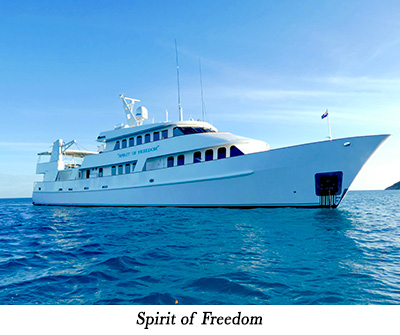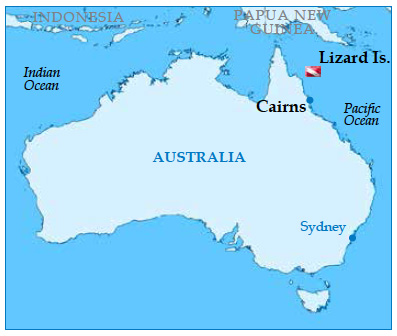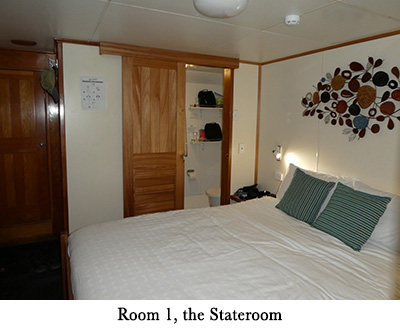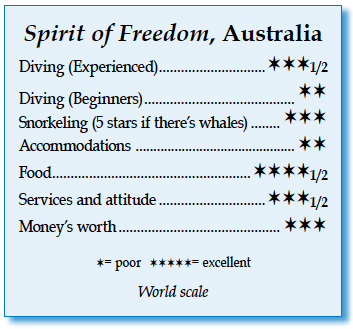Spirit of Freedom, Cairns, AustraliaContents of this Issue: CoCo View Resort, Roatan, Honduras A Tragic Accident Brings a Reminder for Safe Travel Diver Uses Nasal Spray to Clear His Ears While Underwater: Is That Smart? Spirit of Freedom, Cairns, Australia Can Genetic Engineering Save Coral Reefs? For Some Divers, Waiting Only 24 Hours before Flying Is Not Enough Time Beware of False Prophets on Your Dive Trips How Good Are You at Knowing if a Diver Is Drowning? Murder, Bombing and Mass Destruction in Sabah Farewell to a Top Treasure Hunter When That Dive Training Came In Handy Flesh-Eating Bacteria Strikes in Florida Editorial Office: Ben Davison Publisher and Editor Undercurrent 3020 Bridgeway, Suite 102 Sausalito, CA 94965 a cramped, colorless experience on the Great Barrier Reef from the August, 2019 issue of Undercurrent
Dear Fellow Diver: After the big coral-bleaching event in the Great Barrier Reef (GBR) a couple of years ago that made worldwide headlines, I decided I needed to visit there soon, and I created a checklist of 10 must-see GBR animals, including dwarf minke whale, potato cod and pygmy seahorse. When I arrived in July for my seven-day excursion, Alice, the Spirit of Freedom's English tour director, checked my C-card and dive history, and asked me what I wanted to do. I shared my checklist, and with no hesitation, she said it was possible to see them all in a week. I saw more than half of the requested fish and critters, but the jam-packed boat, my bare-bones room and poor reef conditions took most of the excitement away.
Flying through seven time zones, I arrived in Cairns a couple of days beforehand to acclimate. July is dead winter in Australia, but the weather was perfect -- sunny, low humidity and days in the mid-70s -- in the coastal town of Cairns, from where the Spirit of Freedom leaves every Monday, offering three-, four- and seven-day charters. I was picked up at my hotel by a crew member, and just before noon, 24 of us, all divers from around the world, boarded the 122-foot boat, which holds 25 passengers and a crew of 10. I envisioned packed dive decks and mealtimes, and I was right. Two-thirds of the divers were doing the three-day trip, and because they'd be flying back on a small plane from Lizard Island, it took a long time to weigh their luggage for the 45-pound limit. Burgers for lunch weren't served until 3 p.m. Most divers were assigned a guide for the checkout dive. Because we were the most experienced divers by far -- most on my trip had fewer than 50 dives -- my buddy and I were allowed to go on our own, so we were the first to descend to a site called Caves. The water was a chilly 74 degrees (I wore a 7-mm wetsuit and hood), visibility was only 20 feet, and my mask fogged up because the crew who took care of defogging did a bad job. But I spotted some sea cucumbers, a stingray, and hard and soft corals that were in decent health. The day's late start limited that dive to 35 minutes, then we had to perform a few safety skills at the surface, like orally inflating our BCs, showing our boat-issued GPS units, and inflating a surface marker buoy above water, before we could get on board. Alice, also the lead divemaster, promised the dives would get better as the week went on. I was hopeful, but that was a mistake.
Otherwise, the boat was in good shape -- rooms were clean, paint was fresh, and nothing was broken, other than the coffeemaker (which upset a few guests, but I adapted by drinking tea). Alice, with her loud, commanding voice, ran things smoothly with the young divemasters, who came from the U.S., Japan, New Zealand and Australia. On the overcrowded dive deck, there was no way for us all to get geared up at once, so the crew offered "Fin-derella" service. That meant once I had my BC on, I walked down one of the two flights of stairs to the dive platform, and at stair three, a crew member would put fins on my feet and offer to defog my mask.(After the checkout-dive fiasco, I defogged my own.) With 24 divers heading down the stairs, it took a long time for all of us to get into the water. And because most of us arrived from dives simultaneously, a second backlog of divers formed, waiting to climb the one fin-friendly ladder. Crew took our fins off when we returned and even stored them between dives. Safety was a top priority. The dive deck had two crew members logging us in when we entered the water, and a lookout person on the sundeck did the same. Before the boat could move, every person had to be physically accounted for. We were given Nautilus Lifelines and required to dive with snorkels, computers and safety sausages. Our depths and times were recorded upon return, along with remaining air (we were required to be back on board with 700 psi). The crew even looked out for the GBR's safety by offering reef-safe sunscreen. There were always a tender and three dive guides in the water on each dive. A couple of the groups requested a guide every time, but my buddy and I always dived without one. Alice had promised to enlist the crew to help me find the animals on my checklist, but when I twice asked for a guide, I was denied because they were busy. After our 6:30 a.m. "first" breakfast, it was time to give one to the residents at Cod Hole, near Lizard Island. Michelle, the American divemaster, used a site map for the briefing -- depth, current, best way to do the dive, what we might see, depth and time limits -- then gave me directions for finding a pygmy seahorse at 100 feet. As everyone else was shepherded into a circle to watch the giant potato cods get fed fish scraps, we headed to deeper water. Soon, I found the sea fan that the seahorses made their home, including a pink one just a centimeter long. Our return timing was perfect, because the four-foot-long potato cod was just finishing its rounds, and was ready to pose with us for a photo.
Thursday was switchover day, when the three-day passengers fly back, and the four-day passengers arrive. After the first breakfast, we all were loaded into the inflatable tenders and shuttled ashore to Lizard Island. Alice took us on a walk through the mangroves, then Mateo brought over our second breakfast at 9:30 and we munched croissant sandwiches in the shade of the Marlin Bar, on a stunning white-sand beach. Back at the ship, 18 new guests were going through orientation. Not a quiet corner remained. Overnight, Captain Rob steamed us out for the rough and bumpy nine-hour, 100- mile crossing to Osprey Reef. At sunrise, two people were sleeping on the dining room benches, and some had gotten seasick in their bunks before they could make it out to fresh air. I slept through most of it and woke up feeling fine for our first dive, a drift along Blue Marlin Wall. Alice divided us into groups, and each was shuttled out in a tender. We had to step into the inflatables wearing BCs and tanks, but with three-foot seas, the rocking and rolling dinghies made entry challenging. At the reef, six of us back-rolled together into the 76-degree water, but we weren't required to stay together, so my buddy and I began drifting along the steep wall, with lifeless, brown coral. Off in the blue, a couple of reef sharks cruised by. The promised Australian wintertime visibility of 100 to 300 feet did not occur; it was a hazy 60 feet at best (I'd hate to see it in the summer). I kept my depth around 60 feet, and it was an easy 35-minute drift back to the mothership. Blue Marlin Wall was also the site for our shark feed. The surface current was pretty strong, but luckily I could grab the mooring line, and the current calmed during the dive. Alice placed the divers in a semi-circle, sitting or standing on the coral wall, then a crate of tuna heads was lowered. About 20 sharks came in and sniffed the bait before the crate was opened and the feeding frenzy began. When the sand settled, we swam around the site before ending the dive. After lunch, we headed to the dinghy for another drift dive, and the first person in my group made a misstep just as a big wave passed by. She slammed down hard on the dinghy floor, hitting her head and badly injuring her leg. Crew members got her back on board the mother ship, and the diving resumed.
The eight dives at once-glorious Osprey Reef, averaging 30 to 40 minutes each, were a huge disappointment. Shark feed aside, I can't believe we crossed over 100 miles of choppy seas for poor visibility, dead coral and a lack of sea life. Plus there were surface current and waves to deal with when getting into and out of the water -- several divers were swept away and had to be picked up by the tender. Many of them marveled at how beautiful everything was -- but that's because most passengers were newbies who didn't have anything to compare it to. If you've been to Southeast Asia, Micronesia or Fiji, you'll find these sites sad, lifeless, and colorless. After two days at Osprey Reef, the liveaboard made the long, rough crossing back. We were in minke territory for the last day, and on my final dive, an encore at Steve's Bommie, I found the seventh animal on my checklist: a mantis shrimp. Seven out of ten ain't bad, but the overall Spirit of Freedom experience was ho-hum. It would have been better with fewer divers onboard, allowing more space around the dive deck and the three dining tables. (It was too cold and windy on the sundeck to enjoy meals up top.) If the Great Barrier Reef is on your bucket list, see it by all means, and perhaps your captain will find the beauty. I would give a five-star rating for snorkeling here if the minke whales are out, three stars if they're not. But most of what I saw was dead coral and no color, due to bleaching from periods of extremely hot sea temperatures and cyclone damage. It's sad to think this place, once famous for amazing diving, is now a symbol of what climate change is doing to the oceans. It's even worse to think that our political leaders are doing nothing about it, even denying it exists. This is the price we're paying. -- L.E.D. Our Undercover Diver's Bio: "I got certified to dive in Florida in 1998, and received my instructor credentials in 2000. With over 1,200 dives, I've dived in seven mainland U.S. states, over 20 Caribbean islands, British Columbia, Hawaii and Micronesia. As a cave diver, I make regular trips to the Yucatan Peninsula to dive the stunning cenotes. I enjoy researching new places to dive, and have been my own travel agent for the past decade."
|

I want to get all the stories! Tell me how I can become an Undercurrent Online Member and get online access to all the articles of Undercurrent as well as thousands of first hand reports on dive operations world-wide
| Home | Online Members Area | My Account |
Login
|
Join
|
| Travel Index |
Dive Resort & Liveaboard Reviews
|
Featured Reports
|
Recent
Issues
|
Back Issues
|
|
Dive Gear
Index
|
Health/Safety Index
|
Environment & Misc.
Index
|
Seasonal Planner
|
Blogs
|
Free Articles
|
Book Picks
|
News
|
|
Special Offers
|
RSS
|
FAQ
|
About Us
|
Contact Us
|
Links
|
3020 Bridgeway, Ste 102, Sausalito, Ca 94965
All rights reserved.

 June and July are when dwarf minke whales migrate through the GBR's Ribbon Reefs.
Our first dive on the second day was at Steve's Bommie, a pinnacle rising to 15 feet
below the surface, where dwarf minkes are often seen. With 90-foot visibility, I watched
thousands of bright-colored reef fish swarming around the top of the pinnacle, as well
as several types of clownfish, including a real "Nemo," and lots of unicorn tangs. As I
made my way back to the boat, it happened: Three minkes were swimming under my buddy and
me. We hung on the line in the 74-degree water to watch them circle. The crew asked us
to come aboard and drop our gear, but then we could get back in and snorkel with the 16-
to 20-foot giants. Dwarf minkes are the smallest of the baleen whales, but compared to
my 5' 7" frame, they were huge. The Spirit of Freedom adheres to Australia's strict code
of practice, and one requirement is that all divers and snorkelers hold onto a line. The
whales seemed to wait patiently for us, and as soon as we were in place on the line,
they made some close passes. I could distinguish each one from their different gray
and white markings, and noticed some circular scars left from cookie-cutter shark bites.
Each one turned to look at me, eye to eye. Exhilarating.
June and July are when dwarf minke whales migrate through the GBR's Ribbon Reefs.
Our first dive on the second day was at Steve's Bommie, a pinnacle rising to 15 feet
below the surface, where dwarf minkes are often seen. With 90-foot visibility, I watched
thousands of bright-colored reef fish swarming around the top of the pinnacle, as well
as several types of clownfish, including a real "Nemo," and lots of unicorn tangs. As I
made my way back to the boat, it happened: Three minkes were swimming under my buddy and
me. We hung on the line in the 74-degree water to watch them circle. The crew asked us
to come aboard and drop our gear, but then we could get back in and snorkel with the 16-
to 20-foot giants. Dwarf minkes are the smallest of the baleen whales, but compared to
my 5' 7" frame, they were huge. The Spirit of Freedom adheres to Australia's strict code
of practice, and one requirement is that all divers and snorkelers hold onto a line. The
whales seemed to wait patiently for us, and as soon as we were in place on the line,
they made some close passes. I could distinguish each one from their different gray
and white markings, and noticed some circular scars left from cookie-cutter shark bites.
Each one turned to look at me, eye to eye. Exhilarating. I booked Room 1, the stateroom, one of the largest rooms and in a private area,
but I was disappointed as soon as I entered. The queen-sized bed and its two end
tables filled the room, leaving little storage space, and there were just four hangers
in the closet. The only provision in the small, bare-bones bathroom was a quartersized
piece of soap. We only got one bath towel each; no hand towels or washcloths.
While Room 1 was private, the engine room was next door, making it noisy during crossings,
and the galley was above, so I could hear Chef Mateo's footsteps early in the
morning. The twin-share or quad rooms were much smaller than mine. Other guests complained
of their too-cold rooms, but the A/C could not keep my cabin cool enough.
I booked Room 1, the stateroom, one of the largest rooms and in a private area,
but I was disappointed as soon as I entered. The queen-sized bed and its two end
tables filled the room, leaving little storage space, and there were just four hangers
in the closet. The only provision in the small, bare-bones bathroom was a quartersized
piece of soap. We only got one bath towel each; no hand towels or washcloths.
While Room 1 was private, the engine room was next door, making it noisy during crossings,
and the galley was above, so I could hear Chef Mateo's footsteps early in the
morning. The twin-share or quad rooms were much smaller than mine. Other guests complained
of their too-cold rooms, but the A/C could not keep my cabin cool enough. I checked off two other must-sees that day. An olive sea snake showed up at
Lighthouse Bommie, as did the whales. I was swimming at the surface, holding onto the
line, when two whales made a pass six feet beneath me. Then one rose to the surface
to breathe -- I could feel the mist of exhaled water vapor land on my hands and hear
a whooshing sound as air refilled her lungs. I was close enough to reach out and touch
her, but that was against the rules, so I just floated and marveled at her grace and
beauty. At Two Towers, I ogled giant clams the size of truck tires, plus a big green
sea turtle and a huge anemone colony with dozens of clownfish. I celebrated that day's
diving fortune at dinner, an Australian-style barbecue of chicken, pork, and kangaroo,
with a variety of pasta dishes, and a cheese platter for dessert.
I checked off two other must-sees that day. An olive sea snake showed up at
Lighthouse Bommie, as did the whales. I was swimming at the surface, holding onto the
line, when two whales made a pass six feet beneath me. Then one rose to the surface
to breathe -- I could feel the mist of exhaled water vapor land on my hands and hear
a whooshing sound as air refilled her lungs. I was close enough to reach out and touch
her, but that was against the rules, so I just floated and marveled at her grace and
beauty. At Two Towers, I ogled giant clams the size of truck tires, plus a big green
sea turtle and a huge anemone colony with dozens of clownfish. I celebrated that day's
diving fortune at dinner, an Australian-style barbecue of chicken, pork, and kangaroo,
with a variety of pasta dishes, and a cheese platter for dessert. Every morning, my alarm clock was the sound of Chef Mateo's footsteps overhead as
he prepared our 6:30 a.m. wake-up breakfast buffet of fruit, yogurt and cereal. After
the first dive, our second breakfast included eggs, pancakes, and tomatoes or mushrooms.
After the second dive, the lunchtime buffet offered hamburgers, pizza, pasta
dishes, and burritos, as well as fresh fruits and a green salad. Tea time came after
the third dive -- a fruit platter and a sweet snack, like macadamia-and-butterscotch
bars or chocolate eclairs. Because one of the four dining tables was used to lay out
the food, we 25 guests had to pack into three tables, reducing my personal space to
zero. For dinner, we had all four tables to choose from because crew members served
the meals (there was a lot of wasted food because not everyone had the same tastes).
All the drinks -- beer, wine, soft drinks, and bottled water -- cost extra, except
at dinner, when one drink was included. The bar worked on the honor system: you take
something, you write it down.
Every morning, my alarm clock was the sound of Chef Mateo's footsteps overhead as
he prepared our 6:30 a.m. wake-up breakfast buffet of fruit, yogurt and cereal. After
the first dive, our second breakfast included eggs, pancakes, and tomatoes or mushrooms.
After the second dive, the lunchtime buffet offered hamburgers, pizza, pasta
dishes, and burritos, as well as fresh fruits and a green salad. Tea time came after
the third dive -- a fruit platter and a sweet snack, like macadamia-and-butterscotch
bars or chocolate eclairs. Because one of the four dining tables was used to lay out
the food, we 25 guests had to pack into three tables, reducing my personal space to
zero. For dinner, we had all four tables to choose from because crew members served
the meals (there was a lot of wasted food because not everyone had the same tastes).
All the drinks -- beer, wine, soft drinks, and bottled water -- cost extra, except
at dinner, when one drink was included. The bar worked on the honor system: you take
something, you write it down. Divers Compass: My seven-day charter, with 26 dives, was $3,695, double
occupancy, plus an $18 marine park fee, $125 for Nitrox, and charges
for all drinks, including nonalcoholic drinks and bottled water . . .
Most tanks were aluminum 80s with valves that could convert from DIN
to yoke, plus a few larger-capacity steel tanks and a couple of smaller
63s . . . the rental gear -- Scubapro BCs and Cressi regulators and
wetsuits -- was less than a year old . . . seasick medication is a
must and is available for purchase; credit cards or cash (Australian
dollars) are accepted on board . . . electrical outlets in the cabins
are Australian 230V, but there is a charging station with US-style outlets in the forward
lounge . . . No deco diving was allowed; the nearest chamber is in Townsville, 280
miles south of Cairns, and if there was a decompression incident, it would take 8 to 12
hours to return to Cairns by boat . . . Website:
Divers Compass: My seven-day charter, with 26 dives, was $3,695, double
occupancy, plus an $18 marine park fee, $125 for Nitrox, and charges
for all drinks, including nonalcoholic drinks and bottled water . . .
Most tanks were aluminum 80s with valves that could convert from DIN
to yoke, plus a few larger-capacity steel tanks and a couple of smaller
63s . . . the rental gear -- Scubapro BCs and Cressi regulators and
wetsuits -- was less than a year old . . . seasick medication is a
must and is available for purchase; credit cards or cash (Australian
dollars) are accepted on board . . . electrical outlets in the cabins
are Australian 230V, but there is a charging station with US-style outlets in the forward
lounge . . . No deco diving was allowed; the nearest chamber is in Townsville, 280
miles south of Cairns, and if there was a decompression incident, it would take 8 to 12
hours to return to Cairns by boat . . . Website: 